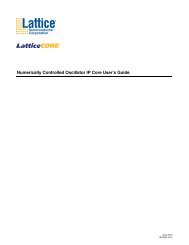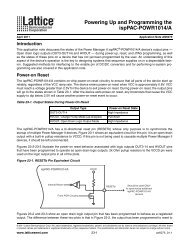DS1036 - Platform Manager Data Sheet - Lattice Semiconductor
DS1036 - Platform Manager Data Sheet - Lattice Semiconductor
DS1036 - Platform Manager Data Sheet - Lattice Semiconductor
Create successful ePaper yourself
Turn your PDF publications into a flip-book with our unique Google optimized e-Paper software.
RESET – This instruction resets the CPLD sequence and output macrocells.<br />
74<br />
<strong>Platform</strong> <strong>Manager</strong> <strong>Data</strong> <strong>Sheet</strong><br />
IN1_RESET_JTAG_BIT – This instruction clears the JTAG Register logic input 'IN1.' The CPLD input has to be<br />
configured to take input from the JTAG Register in order for this command to have effect on the sequence.<br />
IN1_SET_JTAG_BIT – This instruction sets the JTAG Register logic input 'IN1.' The CPLD input has to be configured<br />
to take input from the JTAG Register in order for this command to have effect on the sequence.<br />
CPLD_VERIFY_INCR – This instruction reads out the CPLD data register for the current address and increments<br />
the address register for the next read.<br />
Notes:<br />
In all of the descriptions above, OUTPUTS_HIGHZ refers both to the instruction and the state of the digital output<br />
pins, in which the open-drains are tri-stated and the FET drivers are pulled low.<br />
Before any of the above programming instructions are executed, the respective E 2 CMOS bits need to be erased<br />
using the corresponding erase instruction.<br />
FPGA Section Configuration and Testing<br />
The following section describes the configuration and testing features of the FPGA section of the <strong>Platform</strong> <strong>Manager</strong><br />
device.<br />
IEEE 1149.1-Compliant Boundary Scan Testability<br />
The FPGA section has boundary scan cells that are accessed through an IEEE 1149.1 compliant test access port<br />
(TAP). This allows functional testing of the circuit board, on which the device is mounted, through a serial scan path<br />
that can access all critical logic nodes. Internal registers are linked internally, allowing test data to be shifted in and<br />
loaded directly onto test nodes, or test data to be captured and shifted out for verification. The test access port consists<br />
of dedicated I/Os: PTDI, PTDO, PTCK and PTMS. The test access port shares its power supply with one of<br />
the VCCIO2 banks and can operate with LVCMOS3.3 or 2.5.<br />
For more details on boundary scan test, please see information regarding additional technical documentation at<br />
the end of this data sheet.<br />
FPGA Section Configuration<br />
The FPGA section contains a test access port that can be used for device configuration and programming.<br />
The non-volatile memory of the FPGA section can be configured in two different modes:<br />
In IEEE 1532 mode via the IEEE 1149.1 port. In this mode, the device is off-line and I/Os are controlled by<br />
BSCAN registers.<br />
In background mode via the IEEE 1149.1 port. This allows the device to remain operational in user mode<br />
while reprogramming takes place.<br />
The SRAM configuration memory can be configured in three different ways:<br />
At power-up via internal non-volatile memory.<br />
After a refresh command is issued via the IEEE 1149.1 port.<br />
In IEEE 1532 mode via the IEEE 1149.1 port.<br />
Figure 57 provides a pictorial representation of the different programming modes available in the FPGA section of<br />
the <strong>Platform</strong> <strong>Manager</strong>. On power-up, the SRAM is ready to be configured with IEEE 1149.1 serial TAP port using<br />
IEEE 1532 protocols.









